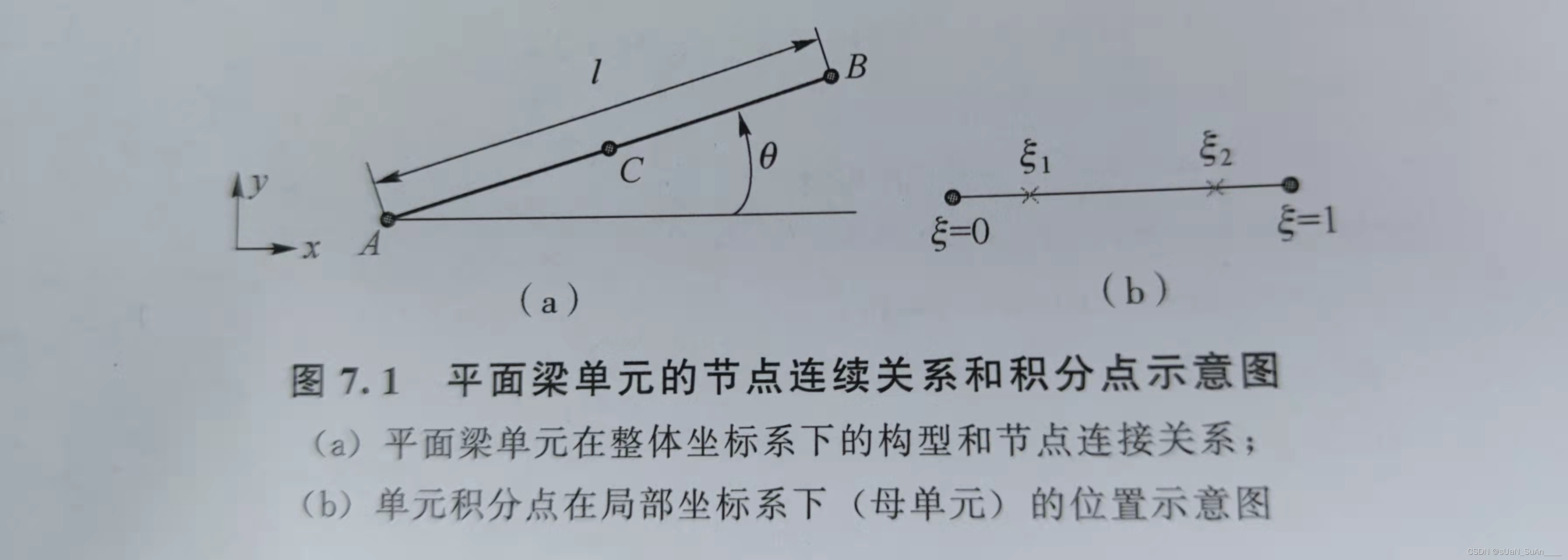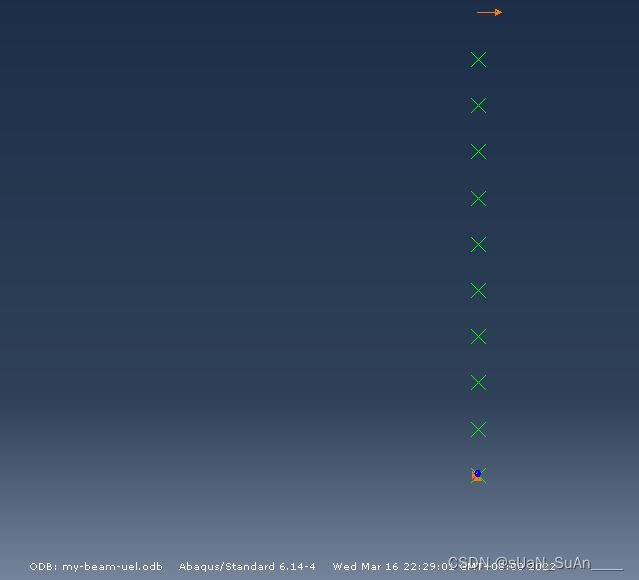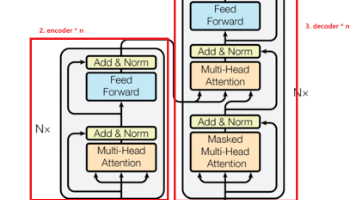一个简单的UEL梁单元(上)
一个简单的ABAQUS的UEL实例,介绍了inp文件的编写和UEL的编写主要是一个平面线弹性梁单元的UEL实现
出于课题需要,学习研究了abaqus uel二次开发,这里通过一个简单的平面线弹性梁单元的UEL实例来复习巩固一下学到的东西,为后续钢筋和混凝土的本构修改做准备。
主要的参考资料为:王涛老师的《基于ABAQUS的有限元子程序开发及应用》和阚前华著的《非线性本构关系在ABAQUS中的实现》 推荐大家看看
图示为实例中使用的单元节点和Gauss积分点位置
添加内部节点C的目的是为了避免切向位移插值采用线性插值( u a , u b u_a,u_b ua,ub)产生恒定的轴向应变,这与法向的三次插值( v a , ϕ a , v b , ϕ b v_a,\phi_a,v_b,\phi_b va,ϕa,vb,ϕb)产生的线性变化曲率不一致。内部节点C仅有一个切向自由度( u c u_c uc)
inp文件的构成
先从inp文件讲起,代码如下:
inp代码
*Heading
** Job name:Job-beam-uel Model name: Model-beam
*Preprint, contact=NO, echo=NO, history=NO, model=NO
**
** PART
**
*Part, name=Part-1
*Node
1, 0., 0.
21, 0., 1.
*NGEN, NSET=all_node
1, 21, 1
*User Element, type=u1, node=3, coordinates=2, variables=8
1, 2, 6
3, 1
*UEL Property, elset=all_element
0.01, 0.02, 2.1e11
*Element, type=u1
1, 1, 3, 2
*ElGEN, elset=all_element
1, 10, 2, 1
*End Part
**
** ASSEMBLY
**
*Assembly, name=Assembly
*Instance, name=Part-1-1, part=Part-1
*End Instance
*Nset, nset=Set-Fix, instance=Part-1-1
1,
*Nset, nset=Set-Load, instance=Part-1-1
21,
*End Assembly
**
** STEP:step-1
**
*step, name=step-1, nlgeom=NO, inc=1000
*static
0.01, 1., 1e-5, 0.01
**
** BOUNDARY CONDITION
**
*Boundary
Set-Fix, 1, 2
Set-Fix, 6, 6
*Boundary
Set-Load, 1, 1, 0.1
**
** OUTPUT REQUESTS
**
*Restart, write, frequency=0
**
** FIELD OUTPUT: F-Output-1
**
*Output, field
*Node Output
U,
**
** HISTORY OUTPUT: H-Output-1
**
*Output, history, frequency=1
*node output, nset=Set-Load
rf1, rf2
*node output, nset=Set-Load
u1, u2
*End Step
有关inp文件的解读也可以参考方自虎老师的教学视频,免费而且非常细致
接下来分部分对inp文件做一个介绍:
分段介绍1:Heading
*Heading
** Job name:Job-beam-uel Model name: Model-beam
*Preprint, contact=NO, echo=NO, history=NO, model=NO
**
abaqus不区分大小写,通过 ∗ + k e y w o r d + d a t a l i n e s * + keyword + data \ lines ∗+keyword+data lines 的形式构成基本语句
通过 ∗ ∗ ** ∗∗表示注释行
*Heading: 表示定义分析的标题,后续的第一行的前80个字符会作为标题打印出来,也可省略为空
*Preprint: 用于选择将从分析输入文件处理器获得的打印输出,对于分析计算无影响
分段介绍2:Part
** PART
**
*Part, name=Part-1
*Node
1, 0., 0.
21, 0., 1.
*NGEN, NSET=all_node
1, 21, 1
*User Element, type=u1, node=3, coordinates=2, variables=8
1, 2, 6
3, 1
*UEL Property, elset=all_element
0.01, 0.02, 2.1e11
*Element, type=u1
1, 1, 3, 2
*ElGEN, elset=all_element
1, 10, 2, 1
*End Part
**
与通过abaqus创建一个完整的job一样需要定义part,这里的部件名为 Part-1 ,首先通过 *Node 方式定义梁的两端节点,再通过 *NGEN 方式,以节点 1 和节点 21 作为首尾节点,以1为节点号数字增量生成节点。
在定义节点后通过 *User Element 定义用户单元,包括:类型u1;单元包含节点数3;单元节点自由度2(平面梁单元);UEL中需要作为数据的属性值的数量,也称状态变量8,根据积分点需要确定,下面两行data lines 第一行代表所有节点的自由度即平动1、平动2、转动6,第二行表示例外的节点,第三个节点,自由度为平动1;
通过 *UEL Property 定义用户单元的属性,梁截面的宽w、高h和材料的弹性模量E。
在定义完UEL的相关参数后,通过 *Element 生成单元1,使用节点为1、3、2,注意这里的编号顺序,该顺序与传入subroutine UEL中的节点顺序一致。
通过 *ElGEN 的方式生成单元,即以单元1为参考,以1单元内节点编号加2的方式生成10个单元,单元编号以1增长。
即生成:单元 2 节点包含3,4,5,单元 3 节点包含5,6,7…
完成部件定义,*End Part
分段介绍3:Assembly
** ASSEMBLY
**
*Assembly, name=Assembly
*Instance, name=Part-1-1, part=Part-1
*End Instance
*Nset, nset=Set-Fix, instance=Part-1-1
1,
*Nset, nset=Set-Load, instance=Part-1-1
21,
*End Assembly
由于部件只有一个,因此装配环节较为简单,在这里定义了两个节点集Nset,分别是支座固定位置1和施加荷载位置21。通过定义节点集有利于后续的荷载、边界条件的施加以及最后计算结果的导出。
分段介绍4:Step-Boundary-Output
** STEP:step-1
**
*step, name=step-1, nlgeom=NO, inc=1000
*static
0.01, 1., 1e-5, 0.01
**
** BOUNDARY CONDITION
**
*Boundary
Set-Fix, 1, 2
Set-Fix, 6, 6
*Boundary
Set-Load, 1, 1, 0.1
**
** OUTPUT REQUESTS
**
*Restart, write, frequency=0
**
** FIELD OUTPUT: F-Output-1
**
*Output, field
*Node Output
U,
**
** HISTORY OUTPUT: H-Output-1
**
*Output, history, frequency=1
*node output, nset=Set-Load
rf1, rf2
*node output, nset=Set-Load
u1, u2
*End Step
最后一部分的代码较为简单,与abaqus可视化操作一致,定义分析步,边界条件,荷载情况和场变量的输出。结合下图应该能够理解每句话的意思,便不再赘述。
建模效果图
一端固定一端施加水平位移
UEL 的实现
UEL原理和功能简述
在讲UEL代码前先简单阐述一下UEL的原理和功能
简单的说使用UEL就是依据上一迭代步的结果和当前的单元节点位移,通过使用UEL来计算右手残差向量RHS和单元刚度矩阵AMATRX
- 单元 [ B ] [B] [B]矩阵将轴向应变和曲率与单元的的位移 [ u e ] [u_e] [ue] 关联
- 材料本构关系矩阵 [ D ] [D] [D] 将轴向力和力矩与轴向应变和曲率相关联
- 单元刚度矩阵可由 [ K e ] = ∫ 0 l [ B ] T [ D ] [ B ] d l [K_e]=\int_0^l[B]^T[D][B]dl [Ke]=∫0l[B]T[D][B]dl 求得
- 实际计算采用数值积分的方式实现
UEL部分代码
通过上述步骤就可以完成 RHS 和 AMATRX 的计算
当然在实际编写UEL过程复杂程度远超上述的几句话,尤其是对于复杂材料的本构实现,下面介绍本实例中采用的平面线弹性梁单元,代码如下:(出于对参考书的知识尊重,没包含ugenb)
subroutine uel(rhs, amatrx, svars, energy, ndofel, nrhs, nsvars,
1 props, nprops, coords, mcrd, nnode, u, du, v, a, jtype, time, dtime,
2 kstep, kinc, jelem, params, ndload, jdltyp, adlmag, predef, npredf,
3 lflags, mlvarx, ddlmag, mdload, pnewdt, jprops, njprop, period)
c
include 'aba_param.inc'
c
dimension rhs(mlvarx, *), amatrx(ndofel, ndofel), svars(*), props(*),
1 energy(8), coords(mcrd,nnode), u(ndofel), du(mlvarx, *), v(ndofel),
2 a(ndofel), time(2), params(*), jdltyp(mdload, *), adlmag(mdload, *),
3 ddlmag(mdload, *),predef(2, npredf, nnode), lflags(*), jprops(*)
dimension b(2,7), gauss(2)
parameter(zero=0.d0, one=1.d0, two=2.d0, three=3.d0, four=4.d0,
1 six=6.d0, eight=8.d0, twelve=12.d0)
data gauss/.211324865d0, .788675135d0/
c
c calculate length and direction cosines
c
dx = coords(1, 2) - coords(1, 1)
dy = coords(2, 2) - coords(2, 1)
dl2 = dx**2 + dy**2
dl = sqrt(dl2)
hdl = dl/two
acos = dx/dl
asin = dy/dl
c
c initialize rhs and amatrx
c
do k1 = 1, 7
rhs(k1, 1) = zero
do k2 = 1, 7
amatrx(k1, k2) = zero
end do
end do
c
c nsvars: User-defined number of solution-dependent state variables associated with the element, with a value of 8
c nsvint: For each integral point has four state variables
c
nsvint=nsvars/2
c
c loop over integral point
c
do kintk = 1, 2
g=gauss(kintk)
c
c make b-matrix, in global coordinates
c
b(1, 1) = (-three+four*g)*acos/dl
b(1, 2) = (-three+four*g)*asin/dl
b(1, 3) = zero
b(1, 4) = (-one+four*g)*acos/dl
b(1, 5) = (-one+four*g)*asin/dl
b(1, 6) = zero
b(1, 7) = (four-eight*g)/dl
b(2, 1) = (-six+twelve*g)*-asin/dl2
b(2, 2) = (-six+twelve*g)* acos/dl2
b(2, 3) = (-four+six*g)/dl
b(2, 4) = (six-twelve*g)*-asin/dl2
b(2, 5) = (six-twelve*g)* acos/dl2
b(2, 6) = (-two+six*g)/dl
b(2, 7) = zero
c
c calculate increment/total strains and curvatures
c eps: axial total strain, deps: incremental axial strain
c cap: curvature, dcap: incremental curvature
c
eps = zero
deps = zero
cap = zero
dcap = zero
do k = 1,7
eps = eps + b(1, k)*u(k)
deps = deps + b(1, k)*du(k, 1)
cap = cap + b(2, k)*u(k)
dcap = dcap + b(2,k)*du(k, 1)
end do
c
c call constitutive routine ugenb
c
isvint = 1+(kintk-1)*nsvint
bn = zero
bm = zero
daxial = zero
dbend = zero
dcouple = zero
call ugenb(bn, bm, daxial, dbend, dcoupl, eps, deps, cap, dcap,
1 svars(isvint), nsvint, props, nprops)
c
c assemble rhs ans amatrx
c
do k1 = 1,7
rhs(k1, 1) = rhs(k1, 1) - hdl*(bn*b(1, k1)+bm*b(2, k1))
bd1 = hdl*(daxial*b(1, k1) + dcoupl*b(2, k1))
bd2 = hdl*(dcoupl*b(1, k1) + dbend*b(2, k1))
do k2 = 1,7
amatrx(k1, k2) = amatrx(k1, k2) + bd1*b(1,k2) + bd2*b(2,k2)
end do
end do
end do
c
return
end
subroutine ugenb(bn,bm,daxial,dbend,dcoupl,eps,deps,cap,dcap,
1 svint,nsvint,props,nprops)
c
include 'aba_param.inc'
c
parameter(zero=0.d0,twelve=12.d0)
c
dimension svint(*),props(*)
c
到这篇幅似乎有些太长了,我放到下一篇文章介绍UEL的内部实现,以上。
结语
课题进展缓慢,模拟也跑的不好,写博客摸摸🐟
最近疫情好严重,希望大家都健健康康的…
更多推荐
 已为社区贡献1条内容
已为社区贡献1条内容








所有评论(0)